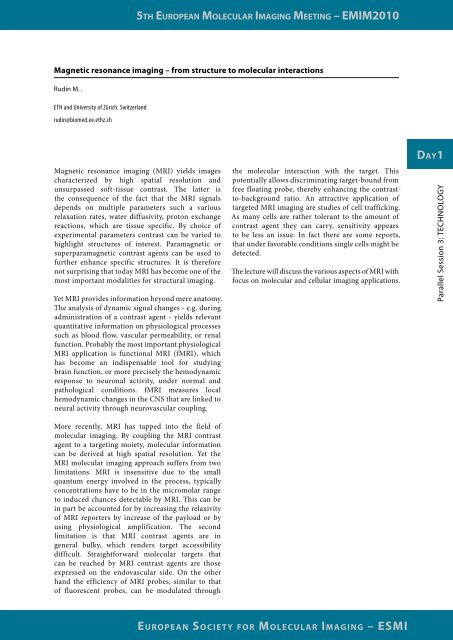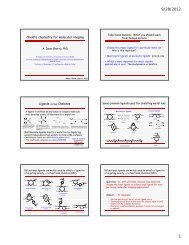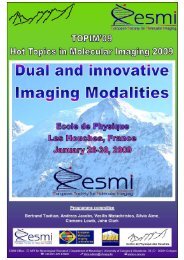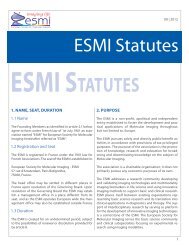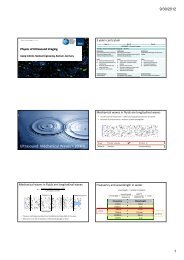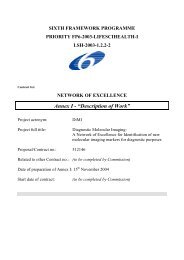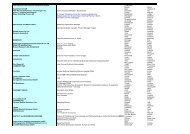5th EuropEan MolEcular IMagIng MEEtIng - ESMI
5th EuropEan MolEcular IMagIng MEEtIng - ESMI
5th EuropEan MolEcular IMagIng MEEtIng - ESMI
Create successful ePaper yourself
Turn your PDF publications into a flip-book with our unique Google optimized e-Paper software.
<strong>5th</strong> <strong>EuropEan</strong> <strong>MolEcular</strong> <strong>IMagIng</strong> <strong>MEEtIng</strong> – EMIM2010<br />
Magnetic resonance imaging – from structure to molecular interactions<br />
Rudin M. .<br />
ETH and University of Zürich, Switzerland<br />
rudin@biomed.ee.ethz.ch<br />
Magnetic resonance imaging (MRI) yields images<br />
characterized by high spatial resolution and<br />
unsurpassed soft-tissue contrast. The latter is<br />
the consequence of the fact that the MRI signals<br />
depends on multiple parameters such a various<br />
relaxation rates, water diffusivity, proton exchange<br />
reactions, which are tissue specific. By choice of<br />
experimental parameters contrast can be varied to<br />
highlight structures of interest. Paramagnetic or<br />
superparamagnetic contrast agents can be used to<br />
further enhance specific structures. It is therefore<br />
not surprising that today MRI has become one of the<br />
most important modalities for structural imaging.<br />
Yet MRI provides information beyond mere anatomy.<br />
The analysis of dynamic signal changes - e.g. during<br />
administration of a contrast agent - yields relevant<br />
quantitative information on physiological processes<br />
such as blood flow, vascular permeability, or renal<br />
function. Probably the most important physiological<br />
MRI application is functional MRI (fMRI), which<br />
has become an indispensable tool for studying<br />
brain function, or more precisely the hemodynamic<br />
response to neuronal activity, under normal and<br />
pathological conditions. fMRI measures local<br />
hemodynamic changes in the CNS that are linked to<br />
neural activity through neurovascular coupling.<br />
More recently, MRI has tapped into the field of<br />
molecular imaging. By coupling the MRI contrast<br />
agent to a targeting moiety, molecular information<br />
can be derived at high spatial resolution. Yet the<br />
MRI molecular imaging approach suffers from two<br />
limitations. MRI is insensitive due to the small<br />
quantum energy involved in the process, typically<br />
concentrations have to be in the micromolar range<br />
to induced chances detectable by MRI. This can be<br />
in part be accounted for by increasing the relaxivity<br />
of MRI reporters by increase of the payload or by<br />
using physiological amplification. The second<br />
limitation is that MRI contrast agents are in<br />
general bulky, which renders target accessibility<br />
difficult. Straightforward molecular targets that<br />
can be reached by MRI contrast agents are those<br />
expressed on the endovascular side. On the other<br />
hand the efficiency of MRI probes, similar to that<br />
of fluorescent probes, can be modulated through<br />
the molecular interaction with the target. This<br />
potentially allows discriminating target-bound from<br />
free floating probe, thereby enhancing the contrastto-background<br />
ratio. An attractive application of<br />
targeted MRI imaging are studies of cell trafficking.<br />
As many cells are rather tolerant to the amount of<br />
contrast agent they can carry, sensitivity appears<br />
to be less an issue. In fact there are some reports,<br />
that under favorable conditions single cells might be<br />
detected.<br />
The lecture will discuss the various aspects of MRI with<br />
focus on molecular and cellular imaging applications.<br />
<strong>EuropEan</strong> SocIEty for <strong>MolEcular</strong> <strong>IMagIng</strong> – <strong>ESMI</strong><br />
day1<br />
Parallel Session 3: TECHNOLOGY


